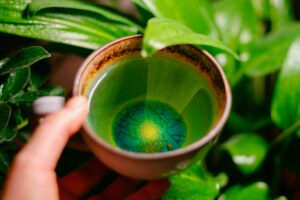Thyme Health Benefits Explained

Many of us use thyme as a standard ingredient in a variety of different dishes. It’s become popular in a number of different cuisines and cultures as a result. However, most of us are largely unaware of the long history that comes with this humble herb. Therefore, people tend to overlook the serious health benefits that this amazing natural product has to offer.
If you’re a believer in the power of holistic healing techniques, then it won’t take much to convince you of the health benefits of thyme. More specifically thyme oil which can provide for you without the downside of side-effects that come with more conventional medications. You should always make time for thyme!
What Is Thyme? Where Does Thyme Come From?

A forest of thyme!
The most popular species of thyme, and the one that you’re most likely to encounter in your supermarkets or grocery stores is known as Thymus vulgaris. It also happens to be one of the oldest varieties of the herb that we know of. Thyme’s exact regional origin is difficult to place, as the herb is (and has been) cultivated around the world for a very long time.
The plant is known for its rich chemical compound content. These are frequently extracted and used in personal or medicinal products. Thymol is a naturally occurring chemical that is based in the leaves and stems of thyme. It has been used for a long time as a natural antiseptic agent to treat topical wounds, preserve meat, and boost your immune system. In the essential oil of thyme, you can expect to find anywhere from 24% to 52% pure thymol in the final product.
Thyme Health Benefits Explained
The health benefits of thyme are well-known to us now thanks to advances in scientific research and analysis technology that is currently available. However, the health properties of this amazing herb have been carried down throughout history by a number of different people.
Due to the rich amount of thymol which is contained in thyme, the plant and it’s essential oil have been used as a natural antiseptic agent for a number of years. It can help to treat topical issues such as toe and foot fungus, cuts, burns, acne and insect bites. It can also help to reduce the occurrence of rashes and general skin infections.
Top 5 Thyme Alternatives Explained: Basil, Oregano, Sage, Marjoram, and Rosemary
1. Basil

Basil growing.
While thyme is a pretty potent natural antiseptic product and is quite healthy in it’s own right, basil packs a more powerful punch in other aspects. This herb is a lot easier to include in a wider variety of meals and dishes. Basil contains a large amount of magnesium, manganese, vitamins A, K and C which helps to boost it’s natural healing potential.
Basil is also well-known for being a potent anti-inflammatory agent and can help to reduce pain, prevent the onset of diabetes by helping to thin the blood and regulate blood-sugar levels. It helps to boost your overall immune system at the same time. This makes it an ideal ingredient to add to a diet or those who suffer from diabetes and is great for fending off the winter time flu. It bolsters your natural defenses against general infection.
2. Oregano
Oregano contains vitamins A, C, E, and K, as well as fiber, folate, iron, magnesium, vitamin B6, calcium, and potassium. This means that it’s a potent natural vitamin and mineral supplement. It can help to boost your bodies natural immune system protecting you against a variety of malignant viruses or infections.
Oregano has a wide and successful history of use in terms of medicinal properties and is well known for its strong antioxidant content, anti-inflammatory, and anti-fungal properties. That makes this herb, and its essential oil, ideal for treating a number of internal and external health issues. You can use oregano to treat foot fungus, UTI’s, help relieve respiratory illness, and to treat food-borne illness or infection.
3. Sage
Sage is loaded with a variety of different vitamins and nutrients necessary to remain healthy. By using sage in your diet on a regular basis, you can help to prevent the onset of infection and disease. It also helps to treat topical ailments such as cuts, wounds, and burns, as well as parasitic infections such as lice.
Sage is known to contain large amounts of vitamin K, and has roughly 43% percent of the recommended daily dosage of this vitamin. Vitamin K is great for improving the quality of your hair, strengthening bone quality and promoting thinner blood. Sage also contains high amounts of vitamin A, C, B, and E, and a number of different minerals, namely manganese, magnesium, calcium, iron and copper.
4. Marjoram
Marjoram is a less specific natural product and you can generally only use it to help prevent the onset of diseases and infection. It can also help to tame internal and external inflammation when used in your diet or as an essential oil for topical use.
Marjoram has been known to possess strong anti-inflammatory properties and can help to treat general pain, fever, and headaches associated with sinus pain or general migraines. You can also use thyme to treat illnesses such as the cold, the flu, measles, and mumps. You can also include it in diets to help lower blood pressure and reduce cholesterol levels.
5. Rosemary

Rosemary growing.
Along with basil, rosemary is probably the next best thing to using thyme or thyme essential. This is due to the fact that it has many of the same chemical components of both plants. This means that rosemary can be used to treat many of the same health ailments as these two herbs and can be combined with them, or their essential oils to help achieve faster or better results in terms of recovery and prevention.
Rosemary can be used as a natural antiseptic, analgesic and anti-inflammatory agent which can be used both internally and topically to help relieve a number of different health ailments. Rosemary contains a large amount of vitamin A and C, which helps to bolster its natural antiseptic properties. Iron and calcium are also present to help bolster your natural defenses, strengthen your blood and bone strength as well.
DIY Thyme Tea Recipe

Thyme tea.
This recipe is based on a healthy tea brew my mother used to make when we were younger. It’s really simple and will help to flush your body of toxins and boost your natural defense mechanisms. It can also give you the energy you need when you’re combating an infection or disease.
What you need:
1x clump of fresh thyme
2x fresh lavender sprigs
3-4x cinnamon sticks
4x cups of tap water
1x pot with a lid
First, add the water to the pot, place the lid on top and bring up the heat on your stove. Once the water starts to boil, add the cinnamon sticks, thyme and lavender to the pot and close the lid. Allow the tea to steep for a while (roughly 3-5 minutes depending on how strong you’d like it to be). Then slowly pour the tea from the pot while keeping the lid on. You can save the leftovers for another brew or allow the remaining water to steep for longer. Drink hot!
Thyme Allergies and Side Effects
Thyme is generally considered a healthy natural ingredient. It’s safe for children of all ages, pregnant, and breastfeeding women, as well as most adults. The main side effect associated with thyme is a slight thinning of the blood. This may increase the likelihood of more bleeding when wounded.
Otherwise, the only possible health hazards that can be associated with thyme are based on direct allergic reactions, but these are quite rare and should be treated on an individual basis. However, you should take note of headaches, swelling, fever, digestive issues, or general pain.
Conclusion
Thyme has a long history of healing through the development of our species. I believe that a lot of the otherwise highly effective natural preventative measures that we’ve relied on over time to keep us healthy and ultimately prevent the onset of disease or infection over the course of our lives has been lost to newer approaches. These often rely on harsh synthetic chemical substances or medicines to help treat the symptoms of these ailments.
While I do think that modern medicine has greatly helped our species develop into a stronger and more capable being, I worry that many of the less polarizing natural remedies of the past are being lost to a culture of consumerism – wherein sickness becomes a means of profit, rather than a problem to solve or a serious issue to treat. So, by using thyme in cooking, remember that you’re invoking a pretty potent natural medicine as well. Be sure to make the most of it!


